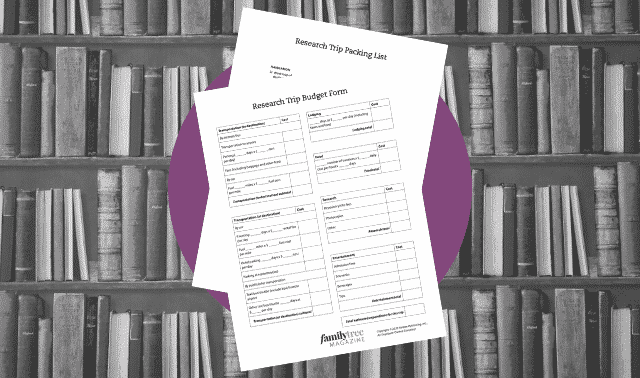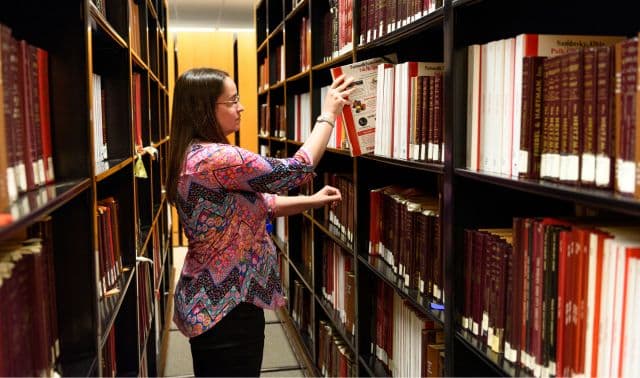Sign up for the Family Tree Newsletter Plus, you’ll receive our 10 Essential Genealogy Research Forms PDF as a special thank you!
Get Your Free Genealogy Forms
"*" indicates required fields

Taking my two sons, Matt, 12, and Andy, 10, on a family history adventure was not my original plan. But when Matt got caught up in the excitement of my genealogy research, I realized the trip would be a wonderful legacy for the three of us to share. Both boys call history their favorite subject, and both particularly enjoyed learning about Colonial America, so we decided to tack visits to Colonial Williamsburg and Washington, DC, onto our 10-day trip.
We left Los Angeles, ready to experience family history up close. Our itinerary included overnight stays in Staunton, Va., the city our immigrant ancestor John Lewis founded in 1747; Williamsburg, Va.; and Loudon County, Va., where friends offered to put us up while we explored DC. Along the way, we planned side trips to Monticello, the Norfolk Naval Air Station and Luray Caverns. But the real treat for the boys would be a half-day canoe trip on the James River, where my fifth-great-grandfather William Crow had operated a ferry and an “ordinary” (a tavern that served meals) just before the Revolutionary War.
We arrived home in early September thrilled at how closely our family’s story mirrors the story of our country. I was gratified that my sons got a chance to connect personally with their brave, proud pioneer ancestors, and my genealogy research came alive in an unimaginable way.
But I also came home with a good sense of what works — and what doesn’t — when taking a family heritage trip with the kids in tow. Here are 10 tips to make your own family heritage adventure a success for you and your children:
1. Think like a kid.
Even if history is your 10-year-old’s favorite subject, he or she probably can sit through only a limited number of historical tours and lectures. I could have spent a happy couple of days in the Staunton library poring over the historical archives, but I knew that kind of focused research time was out of the question on this visit. Plan family heritage activities, but don’t forget to break up the agenda with some more-appealing “kid time.” After all, it’s their vacation, too.
So we did the cave tour and the canoe trip, and we took a regular evening swim to liven up our itinerary. We also made sure we were in our hotel room every night for the Little League World Series, which was being broadcast that week. My sons had been following the tournament, and it was important to them to see the big games. When we got to Williamsburg, I resisted my younger son’s urging that we spend a day at a water park, reasoning that we could visit amusement parks anywhere. It was so miserably hot on our second day at the historical park, however, that we wilted before we could learn much of anything. We would have been better off on the water slide.
2. Plan ahead.
My boys’ favorite vacation question is not “Are we there yet?” It’s “What are we doing next, Mom?” Childish impatience means you probably shouldn’t risk planning on the road or roaming around hoping to stumble across a family landmark. Before we left Los Angeles, I decided what sites we would see, when we would see them and how we were going to find each destination.
Fortunately, my ancestors were prominent settlers, frontiersmen, politicians and soldiers. I was able to consult historical references, including a book written by three descendants, detailing their lives in the Shenandoah Valley. I also met several distant cousins in online genealogy forums, some of whom had visited Virginia. You can connect with your distant cousins using Ancestry and other genealogy websites.
I used my research resources, information from my friends in Virginia and the auto club’s travel-planning service to piece together a road map and a list of must-see landmarks, monuments and graveyards. I booked tickets for Colonial Williamsburg and made motel reservations about six weeks ahead of time, again relying on friends for referrals of kid-friendly places with pools and adjoining restaurants.
3. Ask for help.
It’s amazing what you’ll find out if you just take the time to ask, and people tend to be more accommodating and helpful than we usually realize. I found the Augusta County Historical Society online and wrote to request information, maps, tips and advice. The group’s president was friendly and helpful, sending me addresses, contact information, book recommendations and websites on the area’s historic downtown, as well as links to general Staunton visitor information. She even talked me into becoming a member!
The first night we were in town, we walked into the downtown visitor center and told our story. The woman working the counter was so thrilled to meet descendants of the town’s founder that she dug up some extra information for us and called our hotel room the next day to make sure we’d gotten it. We knocked on the office door at the church our ancestors had helped found. The church secretary looked through dusty old cemetery rolls for us, then signed me up to receive an updated version of the fascinating church history, due out this year.
4. Be flexible.
Traveling with children isn’t easy, and sometimes circumstances arise that require you to put aside your best-laid plans. The night before we left Los Angeles, my older son was sick to his stomach. I didn’t get much sleep, but my son felt fine the next day, and we made our early-morning plane. Arriving on the East Coast exhausted, I was looking forward to a good night’s sleep despite the jet lag. But just as I was dropping off, my younger son turned up at my bedside, grimacing and clutching his stomach. You guessed it: Another night, another sick kid and little sleep for either of us.
What I should have done was make some quick schedule changes and spend the following day — or at least half-day — resting. Unfortunately, I was so determined not to fall behind on my tight schedule that I drove halfway across the state feeling like a zombie. The beauty of Shenandoah National Park went by in a blur as I struggled to stay focused on the road, and we arrived at our hotel just in time for me to stagger into the room and collapse on the bed. Taking some time to recuperate would have been much smarter, not to mention safer and more enjoyable for all of us.
5. Save something for next time.
My itinerary was so packed with must-see historical places that it was almost inevitable some would get crossed off the list. Charged up to visit the places they’ve been reading about for years, adults can forego three meals a day and get by on little rest in order to pack a lot of activity into a short time frame. Kids simply cannot: They get hungry, tired and bored. If you push them, they get cranky and shut down altogether.
So we missed some places I’d planned to see. I wanted to drop by Bellefont House, the Lewis homestead that dated to 1732 and now housed the offices of a local magazine; take a walking tour of historical downtown Staunton; visit Woodrow Wilson’s birthplace in the city; and spend a couple of hours at the Frontier Culture Museum. I was sorry when we didn’t have time to do any of those things, but I’m glad that we have lots to look forward to on our next visit.
6. Expect the unexpected.
Family history treks are part vacation, part adventure. And unlike a cruise or a resort, adventures are unpredictable. You go into them not knowing exactly what will — or won’t — work out. You might meet a distant cousin or find the ruins of the family homestead. Or you might not.
The planned highlight of our trip was to be a visit to John Lewis’ grave site, where an elaborate stone marker detailing his life had been laid by the Daughters of the American Revolution in the 1920s. For months, I had imagined actually touching the stone, taking pictures next to it and perhaps making a grave rubbing of the Latin phrase carved into it: Mortalitate Relicta Vivit Immortalitate Inductus (literally translated, “Mortality relinquished, he lives clothed in immortality”). But Lewis had been buried on a hillside on what is now private property. I had a couple of old sets of detailed directions to the site, but another descendant who had searched for it told me she failed when confronted with a locked gate and a field inhabited by a bull. Still, we were determined to find the gravestone. When the chamber of commerce representative supplied me with a third set of directions and got permission from the property owners for us to cross their land, it looked like we would succeed.
We drove to the property, gamely scaled several sets of fences, ignored stares from the cows and fanned out across a hillside knee-deep in thick grass. We followed the directions as best we could: “Hop the board fence and walk 300 paces toward the lone sycamore tree on top of the hill.” Two hours later, sweaty and starving, we were still clutching our directions and scanning the open fields and hills, doubling back over our tracks again and again. Either the instructions we had were totally wrong, or the low, horizontal gravestone had become so overgrown by weeds it was impossible to find unless we literally stumbled into it. We were disappointed when we finally had to admit defeat, but we decided not to let that failure ruin the rest of our trip.
7. Enjoy delightful surprises.
The nice thing about adventures is that they have a way of delighting as often as they disappoint. When we drove up to the graveyard at the Tinkling Springs Presbyterian Church, we weren’t expecting to find much. So when we gazed up at a beautiful granite marker dedicated to the pioneer founders of the valley and found Lewis’ name on the list, we were thrilled.
Similarly, I had never heard of Michie Tavern, but we stopped there for lunch after touring Monticello, and found out that it was an “ordinary,” founded in 1784. The authentic rough-hewn wood interior, Southern buffet menu and adjacent working mill gave us an unexpected glimpse of what William Crow’s ordinary on the James River probably looked and felt like.
And at Colonial Williamsburg, we were ducking a fierce thunderstorm when we happened across “The Lewis House.” We learned that it had housed some family members when they lived at the capital while serving in Colonial Virginia’s House of Burgesses. When we asked the costumed “Patrick Henry” interpreter at the park if he was acquainted with the Lewis family of Augusta County, he extolled our ancestors as fiercely independent frontiersmen and “true sons of liberty and freedom.” My sons were especially proud to explain that we were “far-distant kin” of the Lewises.
8. Let kids rise to the occasion.
My youngest had never read a map in his life. By the end of the trip, he was navigating for me on the highways and on the river. My oldest proved he could steer a canoe downstream like an old hand, and hung us up on the rocks only a couple of times. Both of them were brave, steadfast, polite to hosts and strangers, and enthusiastic about the trip. They even admitted when we got home that they felt pretty good about coming from such a cool family.
9. Have fun!
Tracing your roots as a family can be a blast if you remember some basics: Make plans, but be prepared to roll with the punches; don’t try too hard to do it all in one visit; make changes if you need to; and be open to letting serendipity show you a good time.
A version of this article appeared in the Summer 2003 issue of Heritage Travel.
ADVERTISEMENT






